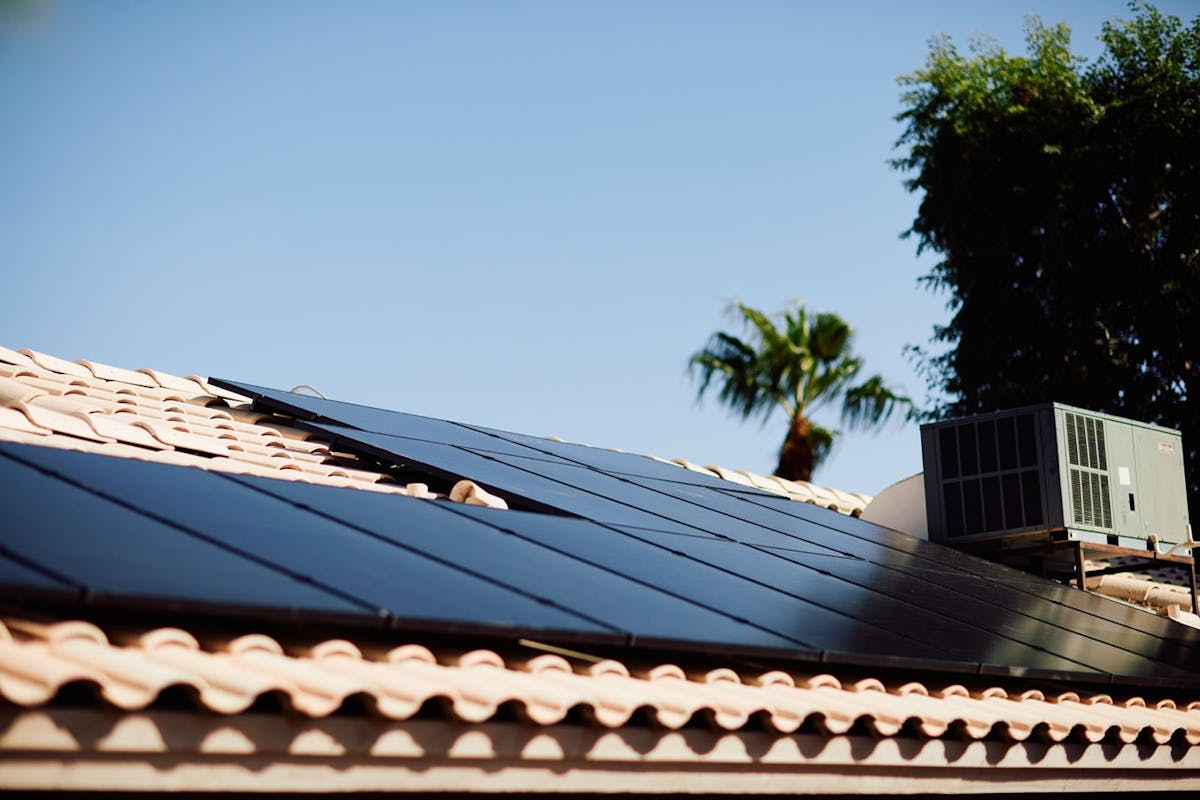Solar Batteries: Benefits and Cost
Last edited

Author
Andrew Giermak
Solar and Electrification Writer and Editor

Editor
Andrew Blok
Electrification and Solar Writer and Editor

More and more homes are getting battery storage installed, whether for backup power or to get more from their home solar panels. In some places, like California and Arizona, batteries are key to unlocking solar savings.
Since the value of batteries varies by location, a trustworthy solar installer can help you decide whether solar or battery storage plus solar is best for your situation. This post will help you start to decide.
Download the free Palmetto app to start working toward a $1,000 discount on a solar battery when you save energy at home.
See how much you can save by going solar with Palmetto
How a Solar Battery Works
When your panels generate more electricity than your property is actively consuming, the electricity can be stored in solar batteries. The stored energy can be discharged through your home’s electrical system to run lights, appliances, and other electronics with clean and free solar power.

Homes typically consume the most energy in the morning and night. Meanwhile, the most productive hours for solar power generation are midday into the afternoon.
Without a solar battery, excess power is fed into the grid. This can earn you net metering credits on your energy bills, at a value determined by your utility under state regulations.
With a battery, some or all of that excess electricity can be stored at home and used to run your home for free instead of purchasing utility company power. In places with lower export credits, a battery can save a lot of money. If your battery is a backup battery, it can also power parts of your home during a blackout.
You can go solar with or without battery storage while interconnected to the energy grid. According to the Solar Energy Industries Association (SEIA), 28% of residential solar projects installed in 2024 included battery storage.
Off-grid vs. grid-connected solar systems
The vast majority of residential solar systems are connected to the grid. When you’re connected to the grid, you don’t have to worry about running out of electricity overnight or during a stretch of cloudy days. With the grid still as a power source for your home, you have more freedom in battery, battery capacity, and cost options.
Solar batteries are essential in off-grid renewable energy systems, where you'll need some source of energy after the sun goes down. When designing an off-grid system, you may need to oversize your battery storage to make it through multi-day stretches of bad weather.
Backup vs. arbitrage batteries
Backup solar batteries are what most solar owners have for energy storage. Backup batteries let you store power and send it to the grid, use it at home to save money or get through a blackout.
Arbitrage batteries, also called consumption-only batteries, only store and sell power to the grid and can’t be used for home backup power. With an arbitrage system you can store energy during free (solar generating) or low-priced times, then sell energy during high-rate, peak, or super-peak periods. Arbitrage batteries only make sense in some locations.
The Benefits of Adding a Solar Battery
Adding solar battery storage to a solar panel system delivers four key benefits: independence, savings, environmental friendliness, and energy resilience.
Energy independence
Adding a battery enables you to decide when your solar power is used, stored, and shared. This can help you keep the lights on, decrease utility bills, and minimize your carbon footprint.
Savings on utility bills
By drawing power from your battery, you can avoid using utility power outside of solar production hours. This is very important if you have a time-of-use rate where batteries can help you avoid costly electricity during peak billing hours.
Cleaner energy at home
By keeping and using more of your solar energy, you can avoid the carbon emissions associated with other energy sources. About 60% of grid energy in the US was generated by fossil fuel resources in 2023.
Backup batteries can be a quieter, cleaner alternative to a backup generator.
Energy security during power outages
Backup batteries can improve your energy security and family’s safety by providing electricity through power outages. Solar panels can refill the batteries when the sun comes out.

Credit: Climate Central
Across the country, weather-related power outages are rising as the effects of climate change increase the frequency and intensity of flash floods, cyclones, extreme heat, wildfires, and other natural disasters.
Consider the February 2021 winter storm which caused power outages for over 4 million Texans. In addition to losing power, some customers were left with massive utility bills, because when access was restored, electricity rates rose more than 7,000% in a matter of days.
According to Climate Central, the number of weather-related power outages in the US in 2014-23 was approximately double the amount in 2000-09.
Solar Battery Costs: Are They Worth It?
Battery prices have fallen rapidly in the last decade, but home solar batteries still cost $10,000 to install. Tax credits can return some of that cost if you qualify (through the end of 2025). Exact solar battery costs vary by manufacturer, installer, and project, and whether things like an electric panel upgrade are required. Also, it's usually most cost-effective to include battery storage as part of installing a new solar system rather than adding to a system years later.
Other factors affecting cost are how much of your home you want to back up during an outage and how often. Your own budget, your area’s net metering plan, and how adding a battery impacts your upfront costs and solar payback period will help you determine if a battery is worth it to you.
Financial Incentives for Home Solar Batteries
You may be eligible for several tax credits, rebates, or financing programs, depending on where you live and the equipment you install.
Tax credits
Solar batteries can qualify for the Residential Clean Energy Credit, also known as the federal solar tax credit. Worth up to 30% of total purchase and installation costs, the incentive is redeemed as a credit against your federal income taxes owed, with no limit on the total amount that can be claimed.
In order to qualify, batteries need to be installed before the end of 2025. Tax credits for leased solar and storage systems, which can benefit you indirectly with lower lease payments, will be available longer.

In addition to the federal tax credit, several states offer state income tax credits for solar panels and home energy storage systems. While eligibility and credit values vary, state income tax credits exist in Arizona, Massachusetts, and New York.
Rebates and battery sharing incentives
You might be able to find state or utility-level incentives for batteries.
For example, Massachusetts, Mass Save Battery Storage Program participants can earn over $1,000 annually for sharing stored power with the grid during periods of peak electricity demand.
Duke Energy's PowerPair program rewards you when you install approved systems and let Duke control your battery during peak demand events.
Finding the Right Solar Battery
Consider the following when you're looking for the right battery. You'll need professional installation and an installer can help match a battery to your needs and budget.
Capacity
A solar battery’s capacity is how much electricity it can store, measured in kilowatt-hours, or kWh. Remember most solar batteries can be stacked to increase your system’s total storage capacity.
Power output
Measured in kilowatts, a solar battery’s power output rating references how much energy it can deliver in one load, whether to your home or the grid. In general, the higher the output rating, the more devices you can power at the same time.
A battery with a low capacity and a high power rating can run many appliances at once, but for a short period of time. On the other hand, a solar battery with a high capacity and a low power rating may only power a few high-demand appliances at once, but for an extended amount of time.
Depth of discharge (DoD)
A battery’s depth of discharge (DoD) is the maximum percentage of its capacity that can be used without the need to recharge.
Draining a battery completely can damage it. The higher the DoD percentage, the more of your battery storage you can safely use.
A 10 kWh capacity battery with a 90% depth of discharge rating will discharge no more than 9 kWh (90% of 10 kWh) of the battery’s power before recharging.
Round-trip efficiency
Round-trip efficiency measures the percentage of energy you put into your battery that you can actually get out. Let’s say your solar panels send 10 kWh into your battery, but you can get 8 kWh back. In this example, your storage system has an 80% round-trip efficiency.
While some energy will always be lost in the electricity storage and use cycle, several of today’s top solar batteries have round-trip operating efficiencies of 90% or higher.
Lifespan and warranty
Solar batteries slowly lose charging capacity and efficiency over time and charging cycles (one cycle = one charge and discharge). In general, solar battery lifespans are 5-15 years.
For example of expected lifespan and warranty terms, a battery may come with a 10-year, 5,000-cycle warranty at 70% capacity. In this instance, the battery should retain at least 70% of its original capacity for up to 10 years or 5,000 charging cycles.
See how much you can save by going solar with Palmetto
Solar Battery Types and Materials
In the US, lithium-ion batteries are the most common storage technology paired with home solar panels today. However, lithium systems are not the only PV storage technology on the market, and there are several other solar battery types to be aware of before finalizing your purchasing decisions.
Lithium-ion
Like batteries in your smartphone, laptop, or electric vehicle, many home batteries use lithium-ion technology. Many battery manufacturers are favoring lithium iron phosphate (LFP) technology for solar energy applications. Compared to non-lithium products, LFP and similar battery types typically come with increased upfront costs, longer lifespans, greater round-trip efficiency, and the best long-term value.
Lead-acid
Similar to batteries in gas-powered vehicles, lead-acid systems are less efficient for storing and using solar electricity. Lead-acid batteries generally aren’t worth it for home solar when compared to lithium-ion alternatives.
Saltwater
Saltwater-based systems known as “flow batteries” are emerging on the solar storage market, though primarily for large-scale, commercial, and utility applications.
How Home Solar Batteries Work With the Energy Grid
Home storage batteries can help solve the duck curve, a problem associated with solar energy capacity and the electricity grid. The solar duck curve is a representation of how grid electricity supplies fluctuate through the day, based on local demand and solar power generation.

Without integrated battery storage, duck curves may get worse throughout the US. Here’s how they work:
- Energy demand is typically highest during the morning and evening, while solar power generation peaks from midday until the late afternoon.
- In the afternoon, too much solar power on the grid can lead to energy oversupplies and net losses.
- After solar-producing hours, utilities must ramp up energy production to meet higher electricity demand in the evening.
Solar batteries can mitigate grid stress in two ways: by capturing excess solar power generation in the afternoon and offsetting utility energy consumption throughout the evening and overnight. Energy from batteries can flatten the curve and balance power supplies.
Battery storage sharing programs are often nicknamed virtual power plants.
Solar Battery Savings: Net Metering and Time-of-Use Rates
When your solar power system sends excess electricity to the grid, your utility may add credit to your energy bills through a net metering or net billing program. The value of this bill credit will vary depending on where you live and often is less than what you pay for electricity.
For example, a utility might charge $0.12 per kWh for power drawn from the grid, but your net billing credits may be worth only $0.05 per kWh. In this case, battery storage could save you money by letting you avoid more grid energy ($0.12 savings) instead of earning bill credits ($0.05 savings).
In some places the value of those export credits varies throughout the day. A battery can let you store up energy to sell it when it's most valuable.
How to Get a Solar Battery
Getting a home battery, whether paired with solar panels or not, requires professional help. Unless your battery is off-grid, you’ll likely need permission from your utility and permits from your city. A reputable installer should help you navigate those steps, as well as get your battery installed safely. Since improper installation can lead to an ineffective battery or a dangerous one, you’ll want to have it installed right.
Palmetto can provide a free estimate based on your current utility bills, available incentives in your area, and the unique features of your property. A solar advisor can walk you through your purchase, lease, or financing options and see if your home is a good fit for solar and storage. To get started, get a free savings estimate today. Or, download the free Palmetto app to learn more about how your home uses energy and start earning rewards that can take $1,000 off the cost of a home battery.
See what solar can do for you:
FAQs
How much energy can a solar battery store?
Solar energy storage is measured in kilowatt-hours (kWh), with typical residential sizes being 5-20 kWh. To increase a system’s capacity, most solar batteries can be installed in banks.
Can solar batteries be recycled?
Yes, many materials in solar batteries are recyclable. Proper disposal is critical for the technology’s overall sustainability and environmental impact. Solar equipment recycling centers are present in most major US cities and becoming more common.
Where can I get the best solar battery?
A reputable solar company should work with you to get the best solar battery and the best overall system design for your home and energy needs. By having a professional supply and install your battery, you can guarantee warranties and complete local and utility legal requirements easier. Reach out to Palmetto to see how a battery could work for you.
Disclaimer: This content is for educational purposes only. Palmetto does not provide tax, legal, or accounting advice. Please consult your own tax, legal, and accounting advisors.


